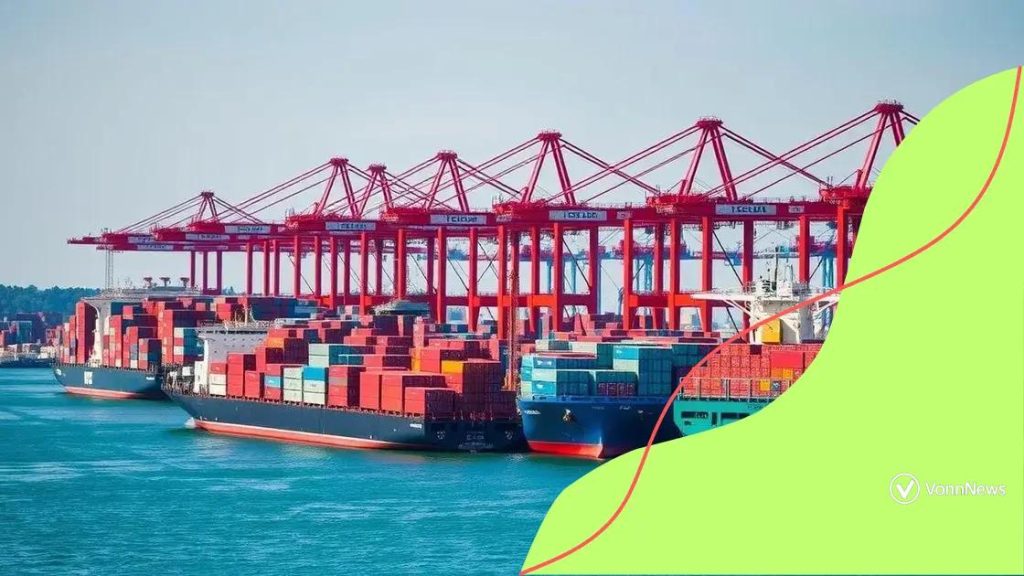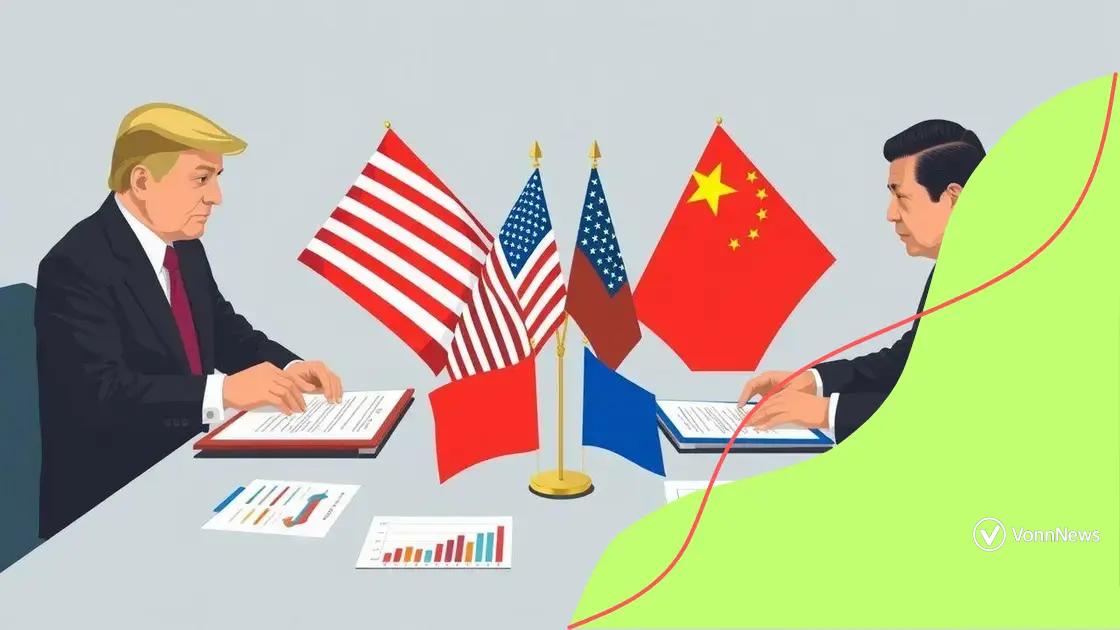US-China trade relations update: what’s new for 2023?

Anúncios
US-China trade relations are influenced by factors such as tariffs, intellectual property concerns, and geopolitical tensions, shaping the future of trade agreements and economic collaboration between the two countries.
The latest US-China trade relations update reveals crucial insights into how shifting policies affect global markets. Curious about what this means for businesses and consumers? Let’s dive into the details.
Anúncios
Current tariffs and their impact
The landscape of tariffs in the US-China trade relations has shifted significantly, impacting various sectors. Understanding these tariffs is crucial for businesses and consumers alike.
Key Tariffs in Place
As of now, several tariffs are enforced on imports from China. The main aim of these tariffs is to protect domestic industries and reduce trade imbalances. However, they can also lead to increased prices for consumers.
- Tariff levels: Current tariffs range from 7.5% to 25% on many goods.
- Sectors affected: Electronics, clothing, and industrial components are heavily impacted.
- Trade balance implications: Tariffs affect import volumes, which can alter the trade balance between the two nations.
Moreover, companies are forced to make tough decisions about their supply chains. Many are considering relocating production to countries with more favorable trade terms. This has led to increased costs in logistics and operations. Consumers may notice these changes, especially with rising prices on various products.
Consequences of Tariffs
The consequences of these tariffs can be profound. One significant effect is the push towards diversification in sourcing. Companies are exploring other markets in Southeast Asia, which could change the global supply chain.
Anúncios
Additionally, industries that rely on imported components might face disruptions. This can lead to delayed production times and increased costs passed on to consumers.
Overall, understanding current tariffs and their implications is vital for anyone involved in international trade, whether as a business owner or a consumer.
Key sectors affected by trade policies
The US-China trade relations have significantly impacted key sectors in both economies. Recognizing which sectors are affected helps businesses and consumers understand broader market dynamics.
Manufacturing Sector
The manufacturing sector has faced the brunt of tariffs and trade restrictions. Companies that rely on imported materials have seen costs increase. This shift has encouraged some businesses to look for suppliers outside of China, leading to diversification.
- Increased costs: Rising prices on raw materials affect production costs.
- Supply chain adjustments: Many manufacturers are reconsidering their supply chains.
- Job impacts: Some industries are cutting jobs due to financial pressures.
Additionally, electronic manufacturers are also feeling the pinch. Tariffs on components can lead to higher prices for consumers. Businesses are exploring alternatives to maintain profitability.
Agricultural Sector
The agricultural sector has been affected by changing trade policies as well. Farmers have struggled due to reduced access to the Chinese market, which once provided a lucrative opportunity.
Examples include the following:
- Reduced soybean exports: American farmers have faced low prices on soybeans.
- Impact on dairy farmers: Tariffs have made it challenging to sell dairy products abroad.
- Market exploration: Farmers are looking to find new buyers.
Consequently, these changes result in challenges for producers and consumers. Many businesses are adapting by seeking alternative markets to stabilize their income.
Technology Sector
The technology sector is another area significantly influenced by trade policies. Companies that import tech components from China face tariffs that may lead to higher consumer prices.
With a focus on innovation, some businesses are looking at how they can shift their production and sourcing strategies. This search for new suppliers can lead to changes in the market landscape.
Overall, it is essential to monitor how these sectors evolve as trade policies continue to develop. Understanding these shifts provides valuable insights for anyone engaged in international business or trade.
Recent trade agreements and negotiations

Recent developments in US-China trade relations have been shaped by ongoing agreements and negotiations. Understanding these changes is vital for businesses and consumers as they navigate this complex landscape.
Overview of Recent Agreements
In the past year, several trade agreements have emerged as both nations seek to redefine their economic ties. These agreements aim to reduce tariffs and improve trade balances.
- New tariff reductions: Some tariffs have been eased, allowing more goods to flow freely between the two countries.
- Focus on technology: Agreements have been made to protect intellectual property and improve access for technology companies.
- Increased agricultural exports: The US has negotiated to increase its agricultural exports to China, which is beneficial for American farmers.
Such changes signify a potential thaw in relations, which can positively affect various sectors. They provide businesses with more opportunities to expand and serve larger markets.
Key Negotiation Points
Several key issues have been central to ongoing negotiations. Both sides are working toward common ground to resolve these matters effectively.
- Trade imbalance: The US aims to reduce the trade deficit by encouraging more exports.
- Market access: Negotiations have focused on creating fair access for all sectors, including technology and agriculture.
- Environmental standards: Recent talks have emphasized the importance of incorporating environmental protections in trade policies.
As these negotiations proceed, businesses are closely monitoring developments. The potential for new agreements can lead to more predictable market conditions, fostering stability in international trade.
Overall, understanding the current state of trade agreements and negotiations is essential for anyone involved in the import-export business. Staying informed enables businesses to adapt and thrive in a changing environment.
Challenges in US-China trade relations
The US-China trade relations face numerous challenges that complicate the economic landscape. Understanding these challenges helps businesses and consumers adapt to a changing environment.
Tariff Wars
One of the biggest challenges remains the ongoing tariff wars between the two nations. High tariffs have created barriers that affect trade flow, causing businesses to pay more for imported goods.
- Increased costs: Tariffs on goods raise prices for consumers and businesses.
- Supply chain disruptions: Companies may struggle to find alternative suppliers, which can delay production.
- Global market impact: These tariffs can create uncertainty in global markets, affecting investments.
The uncertainty driven by tariffs often leads to hesitance in business expansion and planning. Companies must consider how tariffs will affect their pricing strategies and profit margins.
Intellectual Property Issues
Another significant challenge involves intellectual property (IP) rights. Many US companies believe their IP is at risk when doing business in China.
This issue has led to mistrust between the two countries, complicating negotiations and economic cooperation.
- Protection of IP: Companies need assurances that their innovations will be protected.
- Legal frameworks: Differences in legal systems make it difficult to enforce IP rights.
- Loss of revenue: Businesses risk losing profits due to IP theft or misuse.
These concerns may discourage companies from investing in each other’s markets. The reluctance to share technology forced by the fear of IP theft impacts collaboration efforts.
Geopolitical Tensions
The broader geopolitical environment further complicates trade relations. Issues such as military presence in disputed regions and differing political ideologies create friction.
This backdrop affects bilateral negotiations, making it challenging to achieve mutually beneficial agreements.
- Investment risks: Companies may hesitate to invest abroad due to political uncertainty.
- Public sentiment: Nationalistic sentiments can influence trade policies.
- Future trade agreements: Geopolitical tensions may hinder progress in new agreements.
Ultimately, understanding these challenges is essential for navigating the complex nature of US-China trade relations. Awareness can help businesses make informed decisions in a fluctuating market.
Future outlook for trade between US and China
The future outlook for trade between the US and China holds significant interest for businesses and policymakers. Anticipating developments can help companies make strategic decisions in an evolving landscape.
Potential Trade Agreements
Both nations are likely to continue pursuing new trade agreements. These agreements aim to enhance economic cooperation and reduce tariffs that hinder trade flows.
- Focus on technology transfer: Future agreements may address issues related to technology sharing and intellectual property rights.
- Environmental standards: Trade deals could incorporate environmental protections, promoting sustainable practices.
- Agricultural exports: The US may seek to expand its agricultural market share in China through new initiatives.
These factors imply a more structured approach to trade, which can foster better international relations and benefit both economies.
Technological Collaboration
As technology continues to advance, collaboration is becoming increasingly important. The US and China are major players in tech innovation, and there is potential for partnerships.
Areas of focus may include:
- AI and robotics: Joint ventures in artificial intelligence development may enhance competitiveness.
- Green technology: Collaboration on renewable energy technologies can lead to mutual benefits.
- Healthcare innovations: Both countries may work together to advance medical technologies and solutions.
Such partnerships could lead to breakthroughs that benefit global consumers and strengthen ties between the nations.
Geopolitical Influences
While the economic outlook appears positive, geopolitical factors can create uncertainty. Tensions related to military matters and political differences might affect trade relations.
Important considerations include:
- Global market impacts: Trade policies are often influenced by international relations and conflicts.
- Investment climate: Geopolitical stability is crucial for long-term investment decisions.
- Public sentiment: Nationalistic feelings can shape trade policies and influence negotiations.
Being aware of these challenges helps companies prepare for potential disruptions in the future.
Overall, the future of US-China trade relations appears poised for opportunities, but caution remains necessary in the face of uncertainty. Companies that adapt to changing dynamics will have a better chance for success in this complex landscape.
FAQ – Frequently Asked Questions about US-China Trade Relations
What are the main challenges in US-China trade relations?
The main challenges include tariff wars, intellectual property concerns, and geopolitical tensions that can impact business operations.
How do tariffs affect consumer prices?
Tariffs increase the cost of imported goods, which can lead to higher prices for consumers.
What future trends should businesses watch for in US-China trade?
Businesses should monitor potential trade agreements, technological collaborations, and geopolitical developments that may impact trade dynamics.
How can companies prepare for changes in trade policies?
Companies can stay informed about policy changes, adapt their supply chains, and seek alternative markets to mitigate risks.